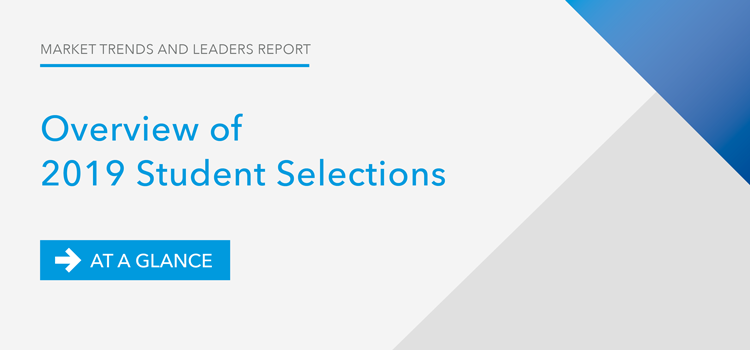Overview of 2019 Student Selections
Tambellini Author

With the publication of Tambellini’s twelfth annual 2020 Student Systems US Higher Education Market Share, Trends, and Leaders Report, many institutions benefit from the in-depth view of the student market trends and updates on the 2019 selections across the higher education landscape. The following are a few highlights from the publication.
- Student selections continued to trend downward from a high of 195 in 2013 to 78 in 2019. With COVID-19, Tambellini expects a further downward trend in 2020 and potentially into 2021. The majority of student selections were awarded Campus Management (29.5%) and Oracle (24%), followed by Jenzabar, Ellucian, Workday, and Unit4.
- 41% of the student system placements are in the private, not-for-profit sector.
- In 2019, 37% of the institutions that made student selections chose a modern SaaS student solution, 30% selected a legacy student SaaS solution, 14% selected a legacy student solution deployed via hosted/managed services, and 19% selected a legacy student solution deployed on-premises.
- There is a growing trend of collaborative purchasing by consortia and state systems.
- Tambellini research shows that an estimated 74% of US higher education institutions are using legacy student systems deployed on-premises.
Things to consider in selecting a next-generation student system
In looking at the trends based on selections, it is also important to track the outcomes of those selections. Many vendors are still in the early stages of their next-generation products, and the lessons learned from institutions are evolving. Institutions should consider the following.
- Today only 4% of US higher education institutions have selected a next-generation student system, and 16% of institutions have migrated from on-premises to vendor-provided cloud solutions. There is more learning for institutions and vendors to support higher education.
- Consider the selection timeline, go-live timeline, and success rate of early adopters. Gain insight into the lessons learned and how to engage effectively with the vendor and campus community throughout the transition.
- A vendor-provided cloud solution may be an option for many institutions to consider, relieving IT of system management, realigning IT resources to support operational changes and use of technology, and potentially delaying a student system selection without negatively impacting progress.
- Choosing a cloud solution requires greater engagement with business stakeholders to review business processes to leverage vendor solutions and best practices.
- IT is no longer customizing the technology to fit the organization.
- Focus is on configuration, requiring an in-depth review of operations and overall goals.
- Departments need to rethink operations.
- Functional teams must know and understand the vendor solution and be deeply engaged in how to use it to meet the organization’s operational and strategic goals.
- Change management is required to address changes a across departments and with the constituents served.
The next-generation student systems continue to evolve, with higher education changing at a faster pace than ever before. Vendors are introducing various approaches and innovations to keep their institutional clients moving forward, enabling the operations and institutional strategy with technology solutions to streamline services.
The COVID-19 impact
While higher education’s strategic vision and direction to the cloud and next-generation student systems have not changed, there is a new focus on ensuring the strategic direction informs the selection and timing. The African proverb “It takes a village to raise a child” rang true for many institutions as they realigned academic delivery and operations while considering the safety of their entire community. This included in many institutions changing how technology was being used, in some cases overnight.
- COVID-19 tested cloud deployments, with institutions reporting ease in changing cloud solutions to address operational changes. With cloud vendors focusing on technology sustainability and stability, institutions were able to focus on the academic needs and outcomes.
- COVID-19 highlighted the need for strategic IT, connecting business requirements and drivers, technology, total cost, ROI, and change management to drive transformation in institutions.
- While Tambellini is seeing institutions delaying decisions by 12 to 18 months, institutions are moving forward, preparing their organizations for change. Areas of focus include data governance and clean-up, business process redesign, and expansion of the use of existing systems to drive automation.
The Tambellini Group continues to foster informed decision making, provide insight on technology advancements, and support institutions from technology strategy to system selection. Reach out to one of our analysts for your free 30 minutes session to discuss how your institution can partner with us to move your technology strategies forward.
Categories
- Academic Administration
- Advancement
- AI and ML
- Content Management
- CRM Platforms
- Customer Experience (CX)
- Cybersecurity
- Data Management and Analytics
- Enterprise Portals and Mobile Apps
- Event Management
- Finance
- HCM/HR
- IT Tools and Infrastructure
- Life at Tambellini
- Services
- Student
- Teaching and Learning
- Technology Leadership
- Thought Leadership
- Uncategorized
Share Article:

Other Posts From this Author:
© Copyright 2025, The Tambellini Group. All Rights Reserved.